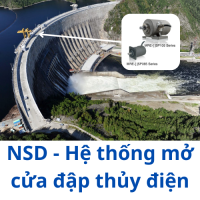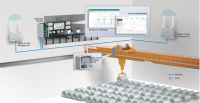Wastewater treatment plant monitors Greenhouse Gas emissions
Globally, little attention is paid to gaseous emissions from wastewater treatment processes. This contrasts greatly with the regulatory monitoring that is applied to the quality of water emissions from such facilities. However, in Helsinki, Finland, a large municipal wastewater treatment facility continuously monitors its emissions of greenhouse gases (GHGs) to help in the city’s efforts to combat climate change and also to help improve the wastewater treatment process.
Employing a multigas FTIR (Fourier Transform InfraRed) analyser from Gasmet, a Helsinki-based manufacturer of analytical instrumentation, the plant’s managers are able to measure the effects of process control on GHG emissions such as carbon dioxide, methane and nitrous oxide. This also provides an insight into the fate of nitrogenous compounds within the wastewater stream.
Background
The Viikinmäki wastewater treatment plant was built in 1994 to process wastewater from both domestic (85%) and industrial (15%) sources. However, the average temperature in Helsinki between December and February is around minus 4 DegC, with extremes below minus 20 and even minus 30 DegC, so the plant was built almost entirely underground to avoid the freezing temperatures. Underground construction is common practice in the Nordic countries, providing other advantages such as land availability above the plant and the provision of stable conditions for process control and odour management.
The Viikinmäki plant is the largest wastewater treatment facility in Finland, handling approximately 270,000 m³ of wastewater per day, which amounts to about 100 million m³ per year. The wastewater is treated in compliance with the Finnish Wastewater Discharge Permit, which is stricter than the EU Water Framework Directive for parameters such as nitrogen removal, phosphate content, BOD, COD and suspended solids. Following treatment, the purified / treated wastewater is conveyed 8km out to sea and to a depth of over 20m. This might seem superfluous, but the 16 km long discharge pipe was built in the 1980s and was designed to ensure that discharged wastewater did not accumulate on the shallow and scattered shore and nature reserves along the coastline of Helsinki.
The treatment process is based on the activated sludge method and includes three phases: mechanical, biological and chemical treatment. Traditional nitrogen removal has been enhanced with a biological filter that utilises denitrification bacteria.
The organic matter contained in the sludge produced in the wastewater treatment process is exploited by digesting the sludge, and the biogas generated in the digestion process is collected for further use. Thanks to the energy produced from biogas, the treatment plant is self-sufficient in terms of heating and about 70 per cent self-sufficient in terms of electricity. However, the plant aims to be fully energy self-sufficient in the near future, and around 60,000 tonnes of dried waste sludge is sold each year for landscaping purposes.
Gas monitoring
As a result of the size of the plant (E-PRTR reporting) and the commitment of the Helsinki Region Environmental Services Authority (HSY) to the protection of the environment, it was necessary to monitor or to model gaseous emissions. At the beginning of the E-PRTR reporting requirements (2007) HSY modelled the annual gaseous emissions based on grab samples. However, monitoring was relatively simple to implement because the plant is enclosed underground and a gas exhaust system was already in place.
Initially, a portable FTIR analyzer from Gasmet was hired for a short period to assess the plant’s emissions and for research purposes. However, as Mari Heinonen, Process Manager at Viikinmäki, reports: “The gas emissions data were very interesting but they were not representative of the annual emissions, and posed more questions than they answered.
“We therefore purchased a continuous emissions monitoring system (CEMS) from Gasmet, which was installed in late 2012 and we now have our first full year’s data for 2013.
“Very little data has been published on the GHG emissions of wastewater treatment and as far as we are aware, Viikinmäki is the only plant in the world conducting this type of monitoring, so our data is likely to be of major significance.”
The Gasmet CEMS employs an FTIR spectrometer to obtain infrared spectra from the waste gas stream by first collecting an ‘interferogram’ of the sample signal with an interferometer, which measures all infrared frequencies simultaneously to produce a spectrum from which qualitative and quantitative data are produced. For example, the CEMS at Viikinmäki continuously displays emissions data for CH4, N2O, CO2, NO, NO2, and NH3.
Over a number of years, Gasmet has established a library of FTIR reference spectra that now extends to simultaneous quantification of 50 gases or identification of unknowns from a collection of 5000+ gases. This means that it is possible to reanalyse produced spectra with the instrument’s PC based software (Calcmet) and thereby to identify unknown gases – a major advantage of FTIR.
Whilst FTIR is able to analyse an enormous number of gases, the technique is not suitable for noble gases, homonuclear diatomic gases (e.g., N2, Cl2, H2, F2, etc) or H2S (detection limit too high).
Gasmet FTIR technology was chosen for the Viikinmäki plant because of its ability to monitor multiple gases simultaneously. However Mari Heinonen says: “The system has performed very well, with very little maintenance required. Zero point calibration with nitrogen (background) just takes a few minutes each day and is fully automated. Water vapour calibration is conducted at least once per year, but under normal circumstances no other calibration is necessary.”
With the benefit of the monitoring data, Mari Heinonen has calculated the annual emissions for methane to be around 350 tonnes, and for nitrous oxide around 134 tonnes. This means that the emissions per cubic meter of wastewater equate to 3.5g of methane and 1.34g of nitrous oxide.
Looking forward, Mari believes that it will be possible to use the gas monitoring data to improve process control: “Traditional monitoring/control systems focus on concentrations of oxygen, nitrate and ammonia in the water, but if we detect high levels of N2O gas for example, this may indicate a problem in the process that we can use as a feedback control.
“The monitoring data for gaseous nitrogen compounds (N2O, NH3, NOx) complements water analysis and provides a more complete picture of the nitrogen cycle in the treatment process.
“Clearly, further research will be required, but this work may indicate a need to consider the fate of nitrogenous compounds beyond just those in the wastewater; the removal of nitrogen from wastewater is a key objective, but if this results in high N2O emissions the process may need to be managed in a different way.”









 Mr Tú
Mr Tú


















